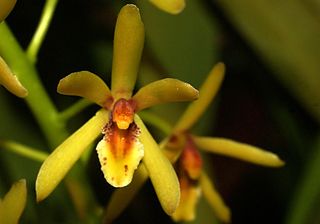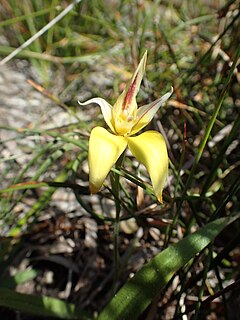
Cymbidium suave, commonly known as the snake orchid or grassy boat-lip orchid, is a plant in the orchid family and is endemic to eastern Australia. It is an epiphytic orchid that forms long-lasting clumps of grass-like leaves. Up to fifty crowded olive green to dark or brownish green flowers are borne on an arching flowering stem. Of the three Australian species of Cymbidium, this is the only one that does not have prominent pseudobulbs. It is found in eastern Australia, usually growing in the hollows of old or fallen, decaying trees.

Sarcochilus, commonly known as butterfly orchids or fairy bells is a genus of about twenty species of flowering plants in the orchid family, Orchidaceae. Most species are epiphytes but a few species only grow on rocks or in leaf litter. Orchids in this genus usually have short stems, leaves arranged in two rows and flowers arranged along unbranched flowering stems. Most species are endemic to Australia but some are found in New Guinea and New Caledonia.

Dipodium punctatum, commonly known as the blotched hyacinth-orchid, is a leafless orchid that is a native to eastern and south-eastern continental Australia. In summer it produces a tall flowering stem with up to sixty pale to bright pink flowers with heavy red blotches. A widespread and common species it is often confused with D. roseum and some authorities regard it as a synonym of D. squamatum.

Cymbidium canaliculatum, commonly known as the channelled boat-lip orchid, tiger boat-lip orchid, native cymbidium or tiger orchid is a plant in the orchid family and is endemic to Australia. It is a clump-forming epiphyte with large, greyish green pseudobulbs, each with up to six curved, deeply channelled leaves and up to sixty fragrant, variably coloured flowers that often have spots and blotches and a white to cream-coloured labellum with red markings. This orchid usually grows in the forks or hollows of trees and is found from New South Wales to the northern parts of Western Australia.

Dendrobium gracilicaule, commonly known as the blotched cane orchid or yellow cane orchid, is an epiphytic or lithophytic orchid in the family Orchidaceae. It has cylindrical pseudobulbs, between three and seven thin leaves and up to thirty often drooping, cream-coloured to yellow or greenish flowers, sometimes with reddish brown blotches on the back. There are two varieties, one occurring in Queensland and New South Wales and the other on some Pacific Islands, including Lord Howe Island.

Dendrobium jonesii, commonly known as the oak orchid is a species of epiphytic or lithophytic orchid endemic to far north Queensland. It has spindle-shaped pseudobulbs, up to seven thin, dark green leaves and up to thirty five crowded, star-like, fragrant cream-coloured or white flowers with purple markings on the labellum.

Sarcochilus falcatus, commonly known as the orange blossom orchid, is a small epiphytic or lithophytic orchid that is endemic to eastern Australia. It has up to eight, leathery leaves with fine teeth on the edges and up to twelve white to cream-coloured flowers with a white labellum that has orange and purple markings.

Dendrobium aemulum, commonly known as the ironbark feather orchid or white feather orchid, is an epiphytic orchid in the family Orchidaceae and grows on trees that retain their bark, especially ironbarks. It has reddish or purplish pseudobulbs, two to four leathery leaves and up to seven white, feathery flowers. It grows in open forest in Queensland and New South Wales.

Genoplesium fimbriatum, commonly known as the fringed midge orchid is a small terrestrial orchid found from southern Queensland to southern New South Wales. It has a single thin leaf and up to thirty green to brownish-green flowers with red stripes and a red-tipped labellum with hairy edges.
Dendrobium brachypus, commonly known as the dwarf cane orchid, is an epiphytic or lithophytic orchid in the family Orchidaceae. It has crowded, yellowish green pseudobulbs, dark green leaves and two or three cream-coloured to whitish or greenish flowers which often do not open fully. It grows on trees and rocks on one mountain on Norfolk Island.

Caladenia flava subsp. sylvestris, commonly known as the karri cowslip orchid, is a species of orchid endemic to the south-west of Western Australia. It has a single, hairy leaf and up to three pale yellow and cream-coloured flowers which are white near the tips of the sepals and petals and marked with bright red or pink.
Corunastylis nigricans, commonly known as the Kangaroo Island midge orchid is a small terrestrial orchid endemic to South Australia. It has a single thin leaf and up to twenty five purplish brown flowers with a shiny, hairless, dark purplish labellum. It is sometimes confused with Genoplesium nigricans which has differently coloured flowers and a much wider distribution. It is regarded as a synonym of G. nigricans by the World Checklist of Selected Plant Families.
Genoplesium baueri, commonly known as the brittle midge orchid, is a small terrestrial orchid which is endemic to New South Wales. It has a single thin leaf and up to nine yellowish green to reddish brown flowers. It is mostly only found in coastal and near-coastal heath and woodland between Port Stephens and Ulladulla.
Thelymitra angustifolia, commonly known as the long-leaved sun orchid is a species of orchid that is endemic to eastern Australia. It has a single erect, thin, channelled leaf and up to ten purplish blue flowers with white tufts on top of the anther. The flowers are self-pollinating.

Dendrobium schoeninum, commonly known as the common pencil orchid, is an epiphytic or sometimes a lithophytic orchid in the family Orchidaceae and has thin wiry, upright or pendent stems with fleshy, grooved, dark green leaves. Its short flowering stems have one or two, rarely up to four pale green, cream-coloured or mauve flowers with purple markings on the labellum. It grows on rainforest margins in coastal New South Wales and southern Queensland.

Dendrobium canaliculatum, commonly known as the brown tea tree orchid or thin tea tree orchid, is an epiphytic or lithophytic orchid in the family Orchidaceae. It has cone-shaped or onion-shaped pseudobulbs, up to six deeply channelled, dark green leaves and up to thirty star-shaped, light brown to caramel-coloured white or greenish to apricot-coloured flowers with darker tips. It grows in tropical North Queensland and New Guinea.

Dendrobium racemosum, commonly known as the erect pencil orchid, is a species of orchid endemic to tropical North Queensland. It is an epiphytic or lithophytic orchid with yellowish stems, cylindrical dark green leaves and flowering stems with between eight and fifteen cream-coloured to pale yellow flowers with a thread-like tip on the labellum. It grows on trees and rocks in exposed positions in highland areas and in the tops of rainforest trees at lower altitudes.
Dendrobium rigidum, commonly known as the smooth tongue orchid or smooth tick orchid, is a species of orchid native to tropical North Queensland and to New Guinea. It is an epiphytic or lithophytic orchid with wiry, hanging stems, fleshy, dark green leaves and flowering stems with between two and seven crowded, cream-coloured, star-shaped flowers often with pink or red on the back. It grows on trees, shrubs and rocks in a paperbark swamps and rainforest.

Dendrobium malbrownii, commonly known as the McIlwraith hermit orchid, is an epiphytic or lithophytic orchid in the family Orchidaceae and is endemic to tropical North Queensland, Australia. It has thin, wiry, crowded stems each with narrow, dark green leaves and a single shiny, cream-coloured flower with a purple labellum. It grows on trees, fallen logs and rocks in rainforest on the McIlwraith Range.
Dendrobium neospectabile, commonly known as the Eungella king orchid, is a species of epiphytic or lithophytic orchid that is endemic to tropical North Queensland. It has cylindrical, yellowish green pseudobulbs, up to three thick, leathery leaves and up to two hundred and fifty crowded cream-coloured to pale yellow flowers with reddish purple streaks on the labellum.














